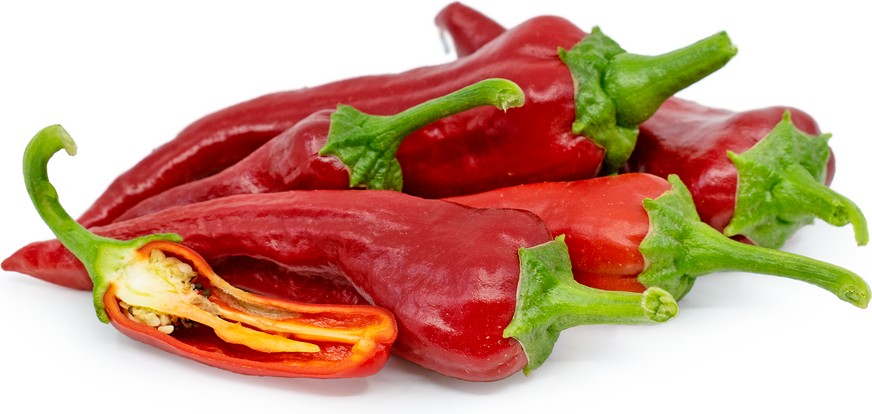


San Felipe Chile Peppers
Estimated Inventory, lb : 0
Description/Taste
San Felipe chile peppers are conical pods, averaging 7 to 10 centimeters in length and 2 to 4 centimeters in diameter, and have broad shoulders that taper to a point on the non-stem end. The skin is smooth, waxy, and slightly wrinkled or creased, ripening from green to dark red when mature. Underneath the surface, the flesh is thin, crisp, and pale red, encasing a central cavity filled with membranes and small, round, and flat cream-colored seeds. San Felipe chile peppers have a mild, earthy flavor with a moderately hot level of spice.
Seasons/Availability
San Felipe chile peppers are available in the late summer through fall.
Current Facts
San Felipe chile peppers, botanically classified as Capsicum annuum, are an heirloom variety that belongs to the Solanaceae or nightshade family. Native to the San Felipe Pueblo in New Mexico, San Felipe chile peppers are regarded as ‘native chiles’ or ‘New Mexico landrace chiles’ as they have adapted to one geographical and climatic area for more than one hundred years. During this time, seeds from the best tasting and hardiest plants were saved and passed down from generation to generation. San Felipe chile peppers are moderately hot, with an average Scoville rating of 15,000 SHU, and are favored for use in salsas, hot sauces, and a wide variety of cooked applications, including tacos, stews, bread, and tamales.
Nutritional Value
San Felipe chile peppers are an excellent source of vitamins A and C, a good source of vitamin K, dietary fiber, and folate, and contain some potassium, manganese, copper, iron, and magnesium. The peppers also contain capsaicin, which is the compound that gives peppers the sensation of spice and provides anti-inflammatory and antioxidant properties.
Applications
San Felipe chile peppers are best suited for both raw and cooked applications such as roasting, frying, and sautéing. The fresh peppers can be added to salsas, ceviche, or sliced and layered into sandwiches, tacos, or burritos. They can also be roasted and diced into dips, macaroni and cheese, eggs, and potatoes, or baked into cornbread and scones. In New Mexico, San Felipe chile peppers are popularly used in their green and red states to make chile sauces. These sauces are considered an everyday table condiment that is used on enchiladas, pasta, burritos, eggs, or grilled meats. They are also commonly stuffed with rice, cheeses, and meats, tossed into stews, or cooked into tamales and rellenos. In addition to cooked preparations, the peppers can be canned or dried and preserved for up to a year. San Felipe chile peppers pair well with meats such as beef, pork, fish, and poultry, corn, cilantro, oregano, rice, beans, limes, avocado, and cheeses such as Monterey jack, goat, cotija, and queso fresco. The fresh peppers will keep up to one week when stored whole and unwashed in a paper or plastic bag in the refrigerator.
Ethnic/Cultural Info
San Felipe chile peppers are named after one of New Mexico’s nineteen Pueblo Indian tribes. Originally named Katishtya, the tribe is situated along the Rio Grande River just north of Albuquerque, New Mexico, and was renamed to San Felipe in 1958 by the Spanish after the patron saint. The San Felipe Pueblo is considered to be one of the more conservative pueblos, actively maintaining their heritage, cultural practices, and traditions of their ancestors, including the Keres language, dancing, and agricultural practices. San Felipe chile peppers are viewed as a community pepper and are cultivated annually on the pueblos land, being resistant to disease, drought, and pests. The seeds are also saved from the ripe, red fruits at the end of each season, and have been traditionally saved for over four hundred years. Within the tribe, San Felipe chile peppers are often served with pumpkin, beans, corn, nuts, and other garden vegetables such as tomatoes and spinach. They are also baked into fresh bread baked daily.
Geography/History
San Felipe chile peppers are native to the San Felipe Pueblo in northern New Mexico, which is located 5,200 feet above sea level along the Rio Grande river. The peppers are known to have been cultivated since the arrival of the Spanish in the 16th century, but some experts believe that the tribes were growing peppers long before the Spanish through pre-Columbian trade routes. Today San Felipe chile peppers have remained localized to their native region and are considered rare outside of the pueblo. The peppers are available through select online vendors, grown by smaller, family-run farms, and are also spotted at local farmer’s markets in the Southeastern United States.




